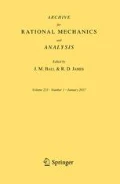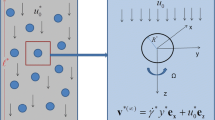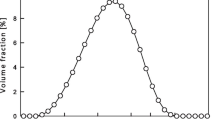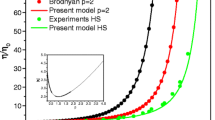Abstract
We provide a mathematical analysis of the effective viscosity of suspensions of spherical particles in a Stokes flow, at low solid volume fraction \(\phi \). Our objective is to go beyond Einstein’s approximation \(\mu _{eff} = (1+\frac{5}{2}\phi ) \mu \). Assuming a lower bound on the minimal distance between the N particles, we are able to identify the \(O(\phi ^2)\) correction to the effective viscosity, which involves pairwise particle interactions. Applying the methodology developped over the last years on Coulomb gases, we are able to tackle the limit \(N \rightarrow +\infty \) of the \(O(\phi ^2)\)-correction, and provide an explicit formula for this limit when the particles centers can be described by either periodic or stationary ergodic point processes.
Similar content being viewed by others
References
Almog, Y., Brenner, H.: Global homogenization of a dilute suspension of spheres. arXiv:2003.01480
Ammari, H., Garapon, P., Kang, H., Lee, H.: Effective viscosity properties of dilute suspensions of arbitrarily shaped particles. Asymptot. Anal. 80(3–4), 189–211, 2012
Basson, A., Gérard-Varet, D.: Wall laws for fluid flows at a boundary with random roughness. Commun. Pure Appl. Math. 61(7), 941–987, 2008
Batchelor, G.: An Introduction to Fluid Dynamics. Cambridge University Press, Cambridge 2002
Batchelor, G., Green, J.: The determination of the bulk stress in a suspension of spherical particles at order \(c^2\). J. Fluid Mech. 56, 401–427, 1972
Batchelor, G., Green, J.: The hydrodynamic interaction of two small freely moving spheres in a linear flow field. J. Fluid Mech. 56, 375–400, 1972
Beliaev, A.Y., Kozlov, S.M.: Darcy equation for random porous media. Commun. Pure Appl. Math. 49(1), 1–34, 1996
Blaszczyszyn, B.: Lecture notes on random geometric models—random graphs, point processes and stochastic geometry. Preprint HAL cel-01654766
Borodin, A., Serfaty, S.: Renormalized energy concentration in random matrices. Commun. Math. Phys. 320(1), 199–244, 2013
Chemin, J.-Y.: Perfect Incompressible Fluids, volume 14 of Oxford Lecture Series in Mathematics and its Applications. The Clarendon Press, Oxford University Press, New York, 1998. Translated from the 1995 French original by Isabelle Gallagher and Dragos Iftimie
Clausius, R.: Die mechanische Behandlung der Elektricität. Vieweg, Braunshweig 1879
Daley, D.J., Vere-Jones, D.: An Introduction to the Theory of Point Orocesses. Vol. II. Probability and Its Applications (New York). Springer, New York, second edition, 2008. General theory and structure
Desvillettes, L., Golse, F., Ricci, V.: The mean-field limit for solid particles in a Navier–Stokes flow. J. Stat. Phys. 131(5), 941–967, 2008
Duerinckx, M., Gloria, A.: Analyticity of homogenized coefficients under Bernoulli perturbations and the Clausius–Mossotti formulas. Arch. Ration. Mech. Anal. 220(1), 297–361, 2016
Einstein, A.: Eine neue Bestimmung der Moleküldimensionen. Ann. Physik. 19, 289–306, 1906
Galdi, G.P.: An Introduction to the Mathematical Theory of the Navier–Stokes Equations. Vol. I, Volume 38 of Springer Tracts in Natural Philosophy. Springer-Verlag, New York, 1994. Linearized steady problems
Gamblin, P., Saint Raymond, X.: On three-dimensional vortex patches. Bull. Soc. Math. France 123(3), 375–424, 1995
Guazelli, E., Morris, J.: A Physical Introduction to Suspension Dynamics. Cambridge University Press, Cambridge 2011
Haines, B.M., Mazzucato, A.L.: A proof of Einstein’s effective viscosity for a dilute suspension of spheres. SIAM J. Math. Anal. 44(3), 2120–2145, 2012
Hasimoto, H.: On the periodic fundamental solutions of the stokes equations and their application to viscous flow past a cubic array of spheres. J. Fluid Mech. 5, 317–328, 1959
Hillairet, M., Wu, D.: Effective Viscosity of a Polydispersed Suspension (2019). arXiv:1905.12306
Hinch, E.: An averaged-equation approach to particle interactions in a fluid suspension. J. Fluid Mech. 83, 695–720, 1977
Höfer, R.M.: Sedimentation of inertialess particles in Stokes flows. Commun. Math. Phys. 360(1), 55–101, 2018
Höfer, R.M., Velázquez, J.J.L.: The method of reflections, homogenization and screening for Poisson and Stokes equations in perforated domains. Arch. Ration. Mech. Anal. 227(3), 1165–1221, 2018
Jabin, P.-E., Otto, F.: Identification of the dilute regime in particle sedimentation. Commun. Math. Phys. 250(2), 415–432, 2004
Jikov, V.V., Kozlov, S.M., Oleĭnik, O.A.: Homogenization of Differential Operators and Integral Functionals. Springer, Berlin 1994. Translated from the Russian by G. A. Yosifian
Keller, J., Rubenfeld, L.: Extremum principles for slow viscous flows with applications to suspensions. J. Fluid Mech. 30, 97–125, 1967
Lévy, T., Sánchez-Palencia, E.: Einstein-like approximation for homogenization with small concentration. II. Navier–Stokes equation. Nonlinear Anal. 9(11), 1255–1268, 1985
Maxwell, J.: A Treatise on Electricity and Magnetism, vol. 1. Clarendon Press, Oxford 1881
Mecherbet, A.: Sedimentation of particles in Stokes flow, 2018. arXiv:1806.07795
Métivier, G.: Intégrales singulières, cours DEA. https://www.math.u-bordeaux.fr/~gmetivie/ISf.pdf 1981 (revised 2005)
Mossotti, O.: Discussione analitica sul’influenza che l’azione di un mezzo dielettrico ha sulla distribuzione dell’elettricità alla superficie di più corpi elettrici disseminati in esso. Mem. Mat. Fis. della Soc. Ital. di Sci. in Modena 24, 49–74, 1850
Niethammer, B., Schubert, R.: A local version of Einstein’s formula for the effective viscosity of suspensions. arXiv:1903.08554
Nunan, K., Keller, J.: Effective viscosity of a periodic suspension. J. Fluid Mech. 142, 269–287, 1984
O’brien, R.: A method for the calculation of the effective transport properties of suspensions of interacting particles. J. Fluid Mech. 91(1), 17–39, 1979
Rougerie, N., Serfaty, S.: Higher-dimensional Coulomb gases and renormalized energy functionals. Commun. Pure Appl. Math. 69(3), 519–605, 2016
Saito, N.: Concentration dependence of the viscosity of high polymer solutions. i. J. Phys. Soc. Jpn. 5(1), 4–8, 1950
Sánchez-Palencia, E.: Einstein-like approximation for homogenization with small concentration. I. Elliptic problems. Nonlinear Anal. 9(11), 1243–1254, 1985
Sandier, E., Serfaty, S.: From the Ginzburg–Landau model to vortex lattice problems. Commun. Math. Phys. 313(3), 635–743, 2012
Sandier, E., Serfaty, S.: 2D Coulomb gases and the renormalized energy. Ann. Probab. 43(4), 2026–2083, 2015
Serfaty, S.: Coulomb Gases and Ginzburg–Landau Vortices. Zurich Lectures in Advanced Mathematics. European Mathematical Society (EMS), Zürich 2015
Zuzovsky, M., Adler, P., Brenner, H.: Spatially periodic suspensions of convex particles in linear shear flows. iii. dilute arrays of spheres suspended in newtonian fluids. Phys. Fluids 26, 1714, 1983
Acknowledgements
We express our gratitude to Sylvia Serfaty for explaining to us her work on Coulomb gases and being a source of fruitful suggestions. We acknowledge the support of the SingFlows Project, Grant ANR-18-CE40-0027 of the French National Research Agency (ANR). D. G.-V. acknowledges the support of the Institut Universitaire de France. M.H. acknowledges the support of Labex Numev Convention Grants ANR-10-LABX-20.
Author information
Authors and Affiliations
Corresponding author
Additional information
Communicated by S. Serfaty
Publisher's Note
Springer Nature remains neutral with regard to jurisdictional claims in published maps and institutional affiliations.
A Proof of Lemma 2.4
A Proof of Lemma 2.4
For any open set U, we denote \(\fint _U = \frac{1}{|U|} \int _U\). By (H2), we have
We write
with
Setting \(y_i = N^{-1/3} x_i\), using that for \(i \ne j\), \(|y_i - y_j| \geqq \frac{1}{2} (c + |y_i - y_j| ) \geqq c\),
From the inequality (2.35), applied with \(a_{ij} = \frac{1}{(c + |y_i - y_j|)^4}\) and \(b_j = A_j\), we deduce
Similarly,
This leads to
The last term is the most difficult. We follow [21]. Let us remind ourselves that
Let \(\chi _d(x) = \chi (x/d)\) a smooth function that is 0 in B(0, d), 1 outside B(0, 2d). Introducing the function \(F_A = \sum _{j} A_j 1_{B(x_j,d)}\), using that \(d \leqq \min _{i \ne j} \frac{|x_i - x_j|}{4}\), we can write that
where \(\mathbf {K}(x)\) is an endomorphism of the space of symmetric matrices, defined by
We then split \(A'_{i,3} = M_i + N_i\), with
By Hölder inequality,
and so
The kernel \(\chi _d \mathbf {K}\) enters the framework of the Calderón–Zygmund theorem, see for instance [31, Chapters 4 and 5]: for all \(1< q <+\infty \), the operator \(\big ( \chi _\mathrm{d}\mathbf {K}\bigr ) \, \star \) is continuous from \(L^q(\mathbb {R}^3)\) to \(L^q(\mathbb {R}^3)\), with
We stress that the constant \(C_q\) depends only on q, and not on d, as can be seen from the rescaling \(x' := x'/d\). It follows that
As the balls \(B(x_j,d)\) are disjoint, \( |\sum A_j 1_{B(x_j,d)}|^q = \sum |A_j|^q 1_{B(x_j,d)}\), so that \(\Vert F_A\Vert _{L^q(\mathbb {R}^3)}^q = \frac{4\pi }{3} \sum |A_j|^q d^3\), and
To bound \(N_i\), we notice that for all \(x \in B_i\), the support of \(x' \rightarrow \chi _d(x_i-x') - \chi _d(x-x')\) is included in
(remark that by definition of \(\phi \), a is less than d for \(\phi \) small enough). We get
so that
using that, for \(\phi \ll 1\), \(a \ll d\) and \(\big |\ln \big (\frac{2d+a}{d-a}\big )\big |\) is bounded by an absolute constant.
Rights and permissions
About this article
Cite this article
Gérard-Varet, D., Hillairet, M. Analysis of the Viscosity of Dilute Suspensions Beyond Einstein’s Formula. Arch Rational Mech Anal 238, 1349–1411 (2020). https://doi.org/10.1007/s00205-020-01567-7
Received:
Accepted:
Published:
Issue Date:
DOI: https://doi.org/10.1007/s00205-020-01567-7




